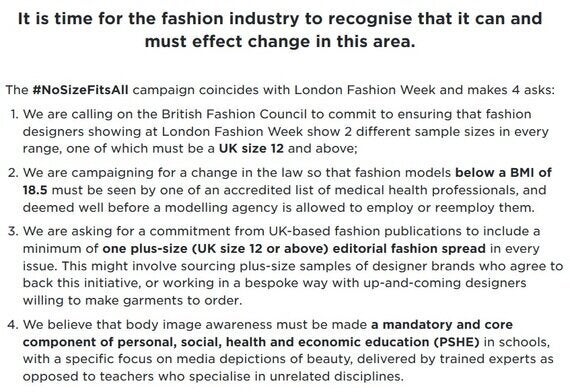The Women's Equality Party launch a new campaign this week to coincide with the start of London Fashion Week. The #NoSizeFitsAll campaign seeks to highlight the prevalence of eating disorders and makes a bold statement regarding the fashion industry's role in this
It is time for the fashion industry to recognise that it can and must effect change in this area.
The Women's Equality Party makes four asks

Image: Women's Equality Party
Many are backing the campaign including fashion activist and diversity campaigner Caryn Franklin and plus size model Jada Sezer along with Rosie Nelson, model and activist who petitioned parliament for government legislation to protect models last year.
Taken at face value the aims of the campaign are laudable. The fashion industry's obsession with thin is often cited as fuelling a desirability with attaining an unrealistic and unhealthy body. To counter this we have seen a real push to see greater diversity on the catwalk, on the high street and in magazines and publications.
The growth of 'plus size', the body positive movement and campaigns such as Dove's Real Beauty have created a greater acceptance and awareness of diversity. Campaign group and registered charity Models of Diversity are at the forefront of this drive as demonstrated by the mission statement
The promotion of equality and diversity for the public benefit by promoting greater diversity in the fashion, beauty and media industries, where people of minority ethnic origin, older people, larger and smaller people, people with a disability, and non-binary gender people are under-represented.
Many will point to the fashion industry and state that it's rare to see overweight models promoted whereas underweight has been the norm for years. Enforcing a ban on underweight models, and insisting those with a BMI less than 18.5 be signed off as healthy before they can be employed, would bring us into line with laws in France, Spain and Italy.
But if we accept there is danger in 'too thin' then we also need to acknowledge the issue with 'too fat'. If we ban anorexia and underweight from the catwalk are we also going to ban obesity and overweight too? Why are we demonising 'skinny'?
When someone is underweight society has no problem labelling them 'anorexic' 'skinny' 'dangerously thin' and is quick to apportion blame. If only you would eat more, stop starving yourself, we say, because this works so well in reverse. We know that telling someone with a weight management problem they simply need to stop eating so much works a treat, we can see how effective that strategy is with a current statistic in the UK revealing 24% are obese and 36% are overweight.
There are many reasons why people are underweight. Not eating enough is an outcome not a reason, to uncover the real issue we need to look a little deeper. From serious psychological problems, illness, underlying medical conditions, bereavement, stress, divorce or abuse the reasons people are underweight are equally as complex, and deserve just as much compassion and understanding, as those who are overweight.
If we are going to use BMI as a tool by which to judge 'too thin' to catwalk then we also need to apply it to 'too big' because obesity is a national epidemic and we are losing the battle. In the UK 65% of men and 58% of women are now classified as overweight and shockingly 9% of all reception aged children (age 4-5) are obese.
Whilst we need to be concerned about fashion and media images promoting overly thin models, we need to recognise the flip side of this. Ashley Graham, Tess Holliday and Felicity Hayward are some of the best known bigger models who have been at the forefront of the shift to celebrate more curvy women. Many have seen this as a really positive step to promoting inclusivity, challenging the 'ideal' body type, and addressing our obsession with 'thin'. But what would happen if we applied the BMI guidelines to all models regardless of size? Strictly speaking if we are going to use BMI to determine health then we need to acknowledge the 'healthy' range is between 18.5 and 29.5.
BMI is a controversial and crude method for calculating healthy bodyweight, as many doctors and health and fitness experts already know. The major flaw being, it doesn't distinguish between fat and muscle, and dividing people into 'weight' categories does not equate to 'health' categories.
It's brilliant we no longer find it acceptable to stigmatise people according to body size. It's fantastic we recognise the worrying influence of fashion and media images that promote an unhealthy body size. However, we run the risk of normalising and trivialising the dangers in being overweight. There are significant health consequences in being overweight including joint problems, lower back pain, hypertension (high blood pressure), coronary heart disease and stroke, deep vein thrombosis, Type 2 diabetes, endometrial, breast and colon cancer, stress incontinence, menstrual abnormalities, erectile dysfunction and respiratory problems. Diabetes alone costs 10% of the NHS budget.
Whilst 1.6 million people in the UK are affected by eating disorders and 5% of girls suffer from anorexia the #NoSizeFitsAll campaign has one major flaw, we can't ban too thin without banning too fat. There's a very fine line between encouraging greater inclusion and diversity and promoting and supporting unhealthy. Striking the right balance is a challenge for all us. It's become very fashionable to support the body positive movement but this latest fashion statement stands to demonise skinny whilst ignoring the bigger issue of fat.